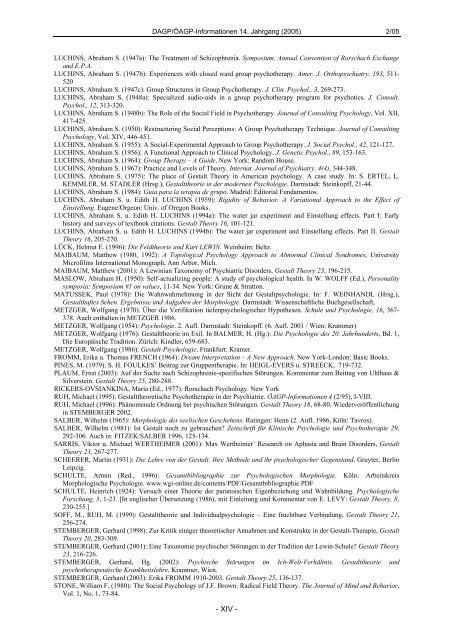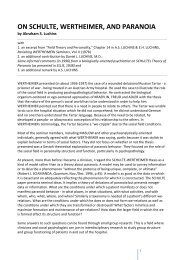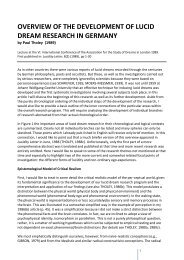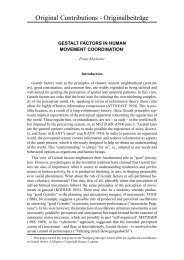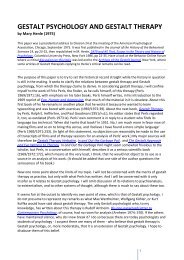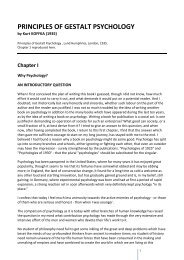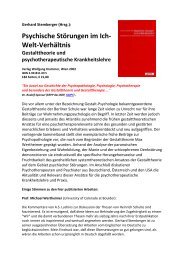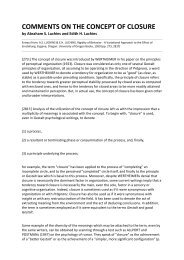Ausgabe 2/2005 - Society for Gestalt Theory and its Applications (GTA)
Ausgabe 2/2005 - Society for Gestalt Theory and its Applications (GTA)
Ausgabe 2/2005 - Society for Gestalt Theory and its Applications (GTA)
Erfolgreiche ePaper selbst erstellen
Machen Sie aus Ihren PDF Publikationen ein blätterbares Flipbook mit unserer einzigartigen Google optimierten e-Paper Software.
DAGP/ÖAGP-In<strong>for</strong>mationen 14. Jahrgang (<strong>2005</strong>) 2/05<br />
LUCHINS, Abraham S. (1947a): The Treatment of Schizophrenia. Symposium, Annual Convention of Rorschach Exchange<br />
<strong>and</strong> E.P.A.<br />
LUCHINS, Abraham S. (1947b): Experiences with closed ward group psychotherapy. Amer. J. Orthopsychiatry, 193, 511-<br />
520<br />
LUCHINS, Abraham S. (1947c): Group Structures in Group Psychotherapy. J. Clin. Psychol., 3, 269-273.<br />
LUCHINS, Abraham S. (1948a): Specialized audio-aids in a group psychotherapy program <strong>for</strong> psychotics. J. Consult.<br />
Psychol., 12, 313-320.<br />
LUCHINS, Abraham S. (1948b): The Role of the Social Field in Psychotherapy. Journal of Consulting Psychology, Vol. XII,<br />
417-425.<br />
LUCHINS, Abraham S. (1950): Restructuring Social Perceptions: A Group Psychotherapy Technique. Journal of Consulting<br />
Psychology, Vol. XIV, 446-451.<br />
LUCHINS, Abraham S. (1955): A Social-Experimental Approach to Group Psychotherapy. J. Social Psychol., 42, 121-127.<br />
LUCHINS, Abraham S. (1956): A Functional Approach to Clinical Psychology. J. Genetic Psychol., 89, 153-163.<br />
LUCHINS, Abraham S. (1964): Group Therapy – A Guide. New York: R<strong>and</strong>om House.<br />
LUCHINS, Abraham S. (1967): Practice <strong>and</strong> Levels of <strong>Theory</strong>. Internat. Journal of Psychiatry, 4(4), 344-348.<br />
LUCHINS, Abraham S. (1975): The place of <strong>Gestalt</strong> <strong>Theory</strong> in American psychology. A case study. In: S. ERTEL, L.<br />
KEMMLER, M. STADLER (Hrsg.), <strong>Gestalt</strong>theorie in der modernen Psychologie. Darmstadt: Steinkopff, 21-44.<br />
LUCHINS, Abraham S. (1984): Guia para la terapia de grupo. Madrid: Editorial Fundamentos.<br />
LUCHINS, Abraham S. u. Edith H. LUCHINS (1959): Rigidity of Behavior. A Variational Approach to the Effect of<br />
Einstellung. Eugene/Orgeon: Univ. of Oregon Books.<br />
LUCHINS, Abraham S. u. Edith H. LUCHINS (1994a): The water jar experiment <strong>and</strong> Einstellung effects. Part I: Early<br />
history <strong>and</strong> surveys of textbook citations. <strong>Gestalt</strong> <strong>Theory</strong> 16, 101-121.<br />
LUCHINS, Abraham S. u. Edith H. LUCHINS (1994b): The water jar experiment <strong>and</strong> Einstellung effects. Part II. <strong>Gestalt</strong><br />
<strong>Theory</strong> 16, 205-270.<br />
LÜCK, Helmut E. (1996): Die Feldtheorie und Kurt LEWIN. Weinheim: Beltz.<br />
MAIBAUM, Matthew (1980, 1992): A Topological Psychology Approach to Abnormal Clinical Syndromes, University<br />
Microfilms International Monograph, Ann Arbor, Mich.<br />
MAIBAUM, Matthew (2001): A Lewinian Taxonomy of Psychiatric Disorders, <strong>Gestalt</strong> <strong>Theory</strong> 23, 196-215.<br />
MASLOW, Abraham H. (1950): Self-actualizing people: A study of psychological health. In W. WOLFF (Ed.), Personality<br />
symposia: Symposium #1 on values, 11-34. New York: Grune & Stratton.<br />
MATUSSEK, Paul (1978): Die Wahnwahrnehmung in der Sicht der <strong>Gestalt</strong>psychologie. In: F. WEINHANDL (Hrsg.),<br />
<strong>Gestalt</strong>haftes Sehen. Ergebnisse und Aufgaben der Morphologie. Darmstadt: Wissenschaftliche Buchgesellschaft,<br />
METZGER, Wolfgang (1970). Über die Verifikation tiefenpsychologischer Hypothesen. Schule und Psychologie, 16, 367-<br />
378. Auch enthalten in METZGER 1986.<br />
METZGER, Wolfgang (1954): Psychologie. 2. Aufl. Darmstadt: Steinkopff. (6. Aufl. 2001 / Wien: Krammer)<br />
METZGER, Wolfgang (1976): <strong>Gestalt</strong>theorie im Exil. In BALMER, H. (Hg.): Die Psychologie des 20. Jahrhunderts, Bd. 1,<br />
Die Europäische Tradition. Zürich: Kindler, 659-683.<br />
METZGER, Wolfgang (1986): <strong>Gestalt</strong>-Psychologie. Frankfurt: Kramer.<br />
FROMM, Erika u. Thomas FRENCH (1964): Dream Interpretation – A New Approach. New York-London: Basic Books.<br />
PINES, M. (1979): S. H. FOULKES’ Beitrag zur Gruppentherapie. In: HEIGL-EVERS u. STREECK, 719-732.<br />
PLAUM, Ernst (2003): Auf der Suche nach Schizophrenie-spezifischen Störungen. Kommentar zum Beitrag von Uhlhaas &<br />
Silverstein. <strong>Gestalt</strong> <strong>Theory</strong> 25, 280-288.<br />
RICKERS-OVSIANKINA, Maria (Ed., 1977): Rorschach Psychology. New York<br />
RUH, Michael (1995): <strong>Gestalt</strong>theoretische Psychotherapie in der Psychiatrie. ÖAGP-In<strong>for</strong>mationen 4 (2/95), I-VIII.<br />
RUH, Michael (1996): Phänomenale Ordnung bei psychischen Störungen. <strong>Gestalt</strong> <strong>Theory</strong> 18, 68-80. Wiederveröffentlichung<br />
in STEMBERGER 2002.<br />
SALBER, Wilhelm (1965): Morphologie des seelischen Geschehens. Ratingen: Henn (2. Aufl. 1986, Köln: Tavros).<br />
SALBER, Wilhelm (1981): Ist <strong>Gestalt</strong> noch zu gebrauchen Ze<strong>its</strong>chrift für Klinische Psychologie und Psychotherapie 29,<br />
292-306. Auch in: FITZEK/SALBER 1996, 125-134.<br />
SARRIS, Viktor u. Michael WERTHEIMER (2001): Max Wertheimer’ Research on Aphasia <strong>and</strong> Brain Disorders, <strong>Gestalt</strong><br />
<strong>Theory</strong> 23, 267-277.<br />
SCHEERER, Martin (1931): Die Lehre von der <strong>Gestalt</strong>. Ihre Methode und ihr psychologischer Gegenst<strong>and</strong>, Gruyter, Berlin<br />
Leipzig.<br />
SCHULTE, Armin (Red., 1996): Gesamtbibliographie zur Psychologischen Morphologie. Köln: Arbe<strong>its</strong>kreis<br />
Morphologische Psychologie. www.wgi-online.de/contents/PDF/Gesamtbibliographie.PDF<br />
SCHULTE, Heinrich (1924): Versuch einer Theorie der paranoischen Eigenbeziehung und Wahnbildung. Psychologische<br />
Forschung, 5, 1-23. [In englischer Übersetzung (1986), mit Einleitung und Kommentar von E. LEVY: <strong>Gestalt</strong> <strong>Theory</strong>, 8,<br />
230-255.]<br />
SOFF, M., RUH, M. (1999): <strong>Gestalt</strong>theorie und Individualpsychologie – Eine fruchtbare Verbindung, <strong>Gestalt</strong> <strong>Theory</strong> 21,<br />
256-274.<br />
STEMBERGER, Gerhard (1998): Zur Kritik einiger theoretischer Annahmen und Konstrukte in der <strong>Gestalt</strong>-Therapie, <strong>Gestalt</strong><br />
<strong>Theory</strong> 20, 283-309.<br />
STEMBERGER, Gerhard (2001): Eine Taxonomie psychischer Störungen in der Tradition der Lewin-Schule <strong>Gestalt</strong> <strong>Theory</strong><br />
23, 216-226.<br />
STEMBERGER, Gerhard, Hg. (2002): Psychische Störungen im Ich-Welt-Verhältnis. <strong>Gestalt</strong>theorie und<br />
psychotherapeutische Krankhe<strong>its</strong>lehre, Krammer, Wien.<br />
STEMBERGER, Gerhard (2003): Erika FROMM 1910-2003. <strong>Gestalt</strong> <strong>Theory</strong> 25, 136-137.<br />
STONE, William F. (1980): The Social Psychology of J.F. Brown: Radical Field <strong>Theory</strong>. The Journal of Mind <strong>and</strong> Behavior,<br />
Vol. 1, No. 1, 73-84.<br />
- XIV -


